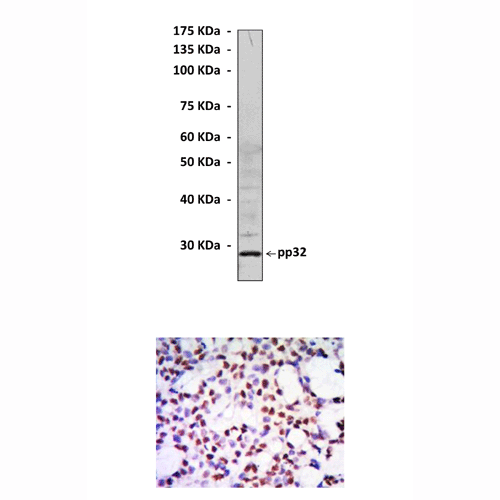Anti-pp32: Mouse pp32 Antibody |
 |
BACKGROUND The pp32 family is comprised of at least three highly conserved proteins encoded by closely-related genes located on different chromosomes. The three genes, pp32, pp32r1, and pp32r2 are functionally distinct despite the high degree of conservation: pp32 acts as a potent tumor suppressor in a number of systems, whereas pp32r1 and pp32r2 are expressed in human cancer and are oncogenic in NIH3T3 cells. In addition, a recent deletion analysis of pp32 mapped the in vitro tumor suppressive activity to a region of approximately 25 amino acids. Interestingly, the sequences of the oncogenic pp32r1 and pp32r2 molecules diverge significantly over precisely this 25 amino acid region, providing independent support for its role in tumor suppression. Deletion of this region in pp32 yielded an inactive molecule with respect to transformation, rather than an oncogenic one, indicating that the oncogenic activities of pp32r1 and pp32r2 are likely to lie in a different region of the molecule.1
pp32 (also known as PHAPI, INHAT) is a nuclear protein found highly expressed in normal tissues in those cells capable of self-renewal and in neoplastic cells. pp32 has been shown to be a binding partner of multiple important proteins. Previous work demonstrated that pp32 is involved in: 1) stabilization of certain mRNAs bearing AU-rich elements (AREs) in the 5′ and 3′ untranslated regions (UTRs) via the interaction of pp32 with the RNA-binding protein HuR (ELAVL1); 2) the modification of histone acetylation through its role in the inhibitor of acetyl transferase complex (termed INHAT); and 3) the modulation of the cell cycle through its interaction with the phosphorylated form of Rb. 4) interaction with Ataxin-1, a protein mutated in the neurodegenerative disease spinocerebellar ataxia type I, suggesting a possible role of PHAPI in this type of neurodegeneration. 5) Inhibition of protein phosphatase 2A (PP2A), which is a crucial regulator for various physiological processes.2
The multiple biochemical activities of pp32 suggest that this protein is involved in diverse biological events. To date, the most defined biological function of pp32I is its role as a tumor suppressor. pp32 expression appears to be greatly decreased during pancreatic cancer progression. In a study of human non-small cell lung cancer, pp32 expression level correlated with improved outcome following chemotherapy. Functionally, overexpression of pp32 can inhibit oncogene-induced tumorigenesis. It was shown that pp32 expression level correlates with the sensitivity of cancer cells to Apaf-1-mediated apoptosis. The apoptotic activity of PHAPI is required for its tumor-suppressive function.3
pp32 (also known as PHAPI, INHAT) is a nuclear protein found highly expressed in normal tissues in those cells capable of self-renewal and in neoplastic cells. pp32 has been shown to be a binding partner of multiple important proteins. Previous work demonstrated that pp32 is involved in: 1) stabilization of certain mRNAs bearing AU-rich elements (AREs) in the 5′ and 3′ untranslated regions (UTRs) via the interaction of pp32 with the RNA-binding protein HuR (ELAVL1); 2) the modification of histone acetylation through its role in the inhibitor of acetyl transferase complex (termed INHAT); and 3) the modulation of the cell cycle through its interaction with the phosphorylated form of Rb. 4) interaction with Ataxin-1, a protein mutated in the neurodegenerative disease spinocerebellar ataxia type I, suggesting a possible role of PHAPI in this type of neurodegeneration. 5) Inhibition of protein phosphatase 2A (PP2A), which is a crucial regulator for various physiological processes.2
The multiple biochemical activities of pp32 suggest that this protein is involved in diverse biological events. To date, the most defined biological function of pp32I is its role as a tumor suppressor. pp32 expression appears to be greatly decreased during pancreatic cancer progression. In a study of human non-small cell lung cancer, pp32 expression level correlated with improved outcome following chemotherapy. Functionally, overexpression of pp32 can inhibit oncogene-induced tumorigenesis. It was shown that pp32 expression level correlates with the sensitivity of cancer cells to Apaf-1-mediated apoptosis. The apoptotic activity of PHAPI is required for its tumor-suppressive function.3
REFERENCES
1. Bai, J. et al: Oncogene 20:2153-60, 2001
2. Williams, T.K. et al: PLoS ONE 5:e15455, 2010
3. Pan, W. et al: J. Biol. Chem. 284:6946-54, 2009
2. Williams, T.K. et al: PLoS ONE 5:e15455, 2010
3. Pan, W. et al: J. Biol. Chem. 284:6946-54, 2009
Products are for research use only. They are not intended for human, animal, or diagnostic applications.
Параметры
Cat.No.: | CP10293 |
Antigen: | Raised against recombinant human pp32 fragments expressed in E. coli. |
Isotype: | Mouse IgG1 |
Species & predicted species cross- reactivity ( ): | Human, Mouse, Rat |
Applications & Suggested starting dilutions:* | WB 1:1000 IP n/d IHC 1:50 - 1:200 ICC n/d FACS n/d |
Predicted Molecular Weight of protein: | 28 kDa |
Specificity/Sensitivity: | Detects endogenous pp32 proteins without cross-reactivity with other family members. |
Storage: | Store at -20°C, 4°C for frequent use. Avoid repeated freeze-thaw cycles. |
*Optimal working dilutions must be determined by end user.
Документы
Информация представлена исключительно в ознакомительных целях и ни при каких условиях не является публичной офертой








